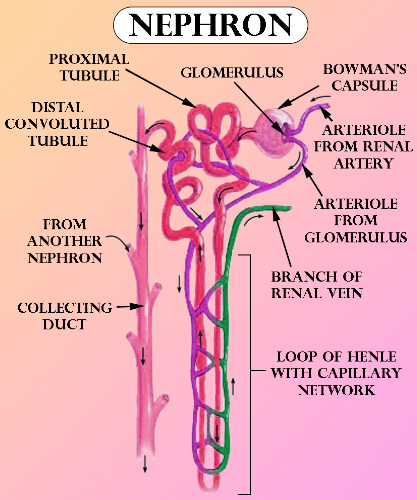
Malpighian/Bowmans/renal corpuscles occur in:
(a) Medulla
(b) Cortex
(c) Pelvis
(d) Pyramid
Answer
425.7k+ views
Hint: The kidney is the main organ of the excretory system. The outer layer is a tough capsule and inside it comprises two zones, an outer cortex, and an inner medulla. The structural and functional unit of kidneys are called nephrons.
Complete solution:
The medulla of the kidney is divided into a few conical masses which are called medullary pyramids which project into the calyces. The cortex extends in between the medullary pyramids as renal columns which are called Columns of Bertini.
There are nearly one million nephrons in kidneys.
A nephron is divided into two parts- Glomerulus and the renal tubule.
A tuft of capillaries formed by the afferent arteriole is the glomerulus. The blood from the glomerulus is carried away by an efferent arteriole.
The renal tubule begins with Bowman’s capsule which is a double-walled cup-like structure that encloses the glomerulus. Glomerulus along with Bowman’s capsule is called renal corpuscle or malpighian body. The tubule continues further to form a highly coiled network which is called the Proximal Convoluted Tubule (PCT). The next part of PCT is called Henle’s loop which comprises a descending and an ascending limb. The ascending limb leads to another highly coiled tubular region called Distal Convoluted Tubule (DCT). DCTs of many other nephrons open into the collecting duct which is a straight tube that converges and opens into the renal pelvis through medullary pyramids in the calyces.
Additional information:
Cortical nephrons are the nephrons in which the loop of Henle is very short and extends very little into the medulla.
Juxta medullary nephrons are the nephrons in which the loop of Henle is very long and runs deep into the medulla.
So, the correct answer is ‘Cortex’.
Note:
The cortical region of the kidney constitutes the Malpighian corpuscles, Proximal Convoluted Tubule (PCT), and Distal Convoluted Tubule (DCT) of the nephron whereas the loop of Henle dips into the medullary region of the kidney.

Complete solution:
The medulla of the kidney is divided into a few conical masses which are called medullary pyramids which project into the calyces. The cortex extends in between the medullary pyramids as renal columns which are called Columns of Bertini.
There are nearly one million nephrons in kidneys.
A nephron is divided into two parts- Glomerulus and the renal tubule.
A tuft of capillaries formed by the afferent arteriole is the glomerulus. The blood from the glomerulus is carried away by an efferent arteriole.
The renal tubule begins with Bowman’s capsule which is a double-walled cup-like structure that encloses the glomerulus. Glomerulus along with Bowman’s capsule is called renal corpuscle or malpighian body. The tubule continues further to form a highly coiled network which is called the Proximal Convoluted Tubule (PCT). The next part of PCT is called Henle’s loop which comprises a descending and an ascending limb. The ascending limb leads to another highly coiled tubular region called Distal Convoluted Tubule (DCT). DCTs of many other nephrons open into the collecting duct which is a straight tube that converges and opens into the renal pelvis through medullary pyramids in the calyces.
Additional information:
Cortical nephrons are the nephrons in which the loop of Henle is very short and extends very little into the medulla.
Juxta medullary nephrons are the nephrons in which the loop of Henle is very long and runs deep into the medulla.
So, the correct answer is ‘Cortex’.
Note:
The cortical region of the kidney constitutes the Malpighian corpuscles, Proximal Convoluted Tubule (PCT), and Distal Convoluted Tubule (DCT) of the nephron whereas the loop of Henle dips into the medullary region of the kidney.

Recently Updated Pages
Glucose when reduced with HI and red Phosphorus gives class 11 chemistry CBSE

The highest possible oxidation states of Uranium and class 11 chemistry CBSE

Find the value of x if the mode of the following data class 11 maths CBSE

Which of the following can be used in the Friedel Crafts class 11 chemistry CBSE

A sphere of mass 40 kg is attracted by a second sphere class 11 physics CBSE

Statement I Reactivity of aluminium decreases when class 11 chemistry CBSE

Trending doubts
10 examples of friction in our daily life

One Metric ton is equal to kg A 10000 B 1000 C 100 class 11 physics CBSE

Difference Between Prokaryotic Cells and Eukaryotic Cells

State and prove Bernoullis theorem class 11 physics CBSE

What organs are located on the left side of your body class 11 biology CBSE

How many valence electrons does nitrogen have class 11 chemistry CBSE




